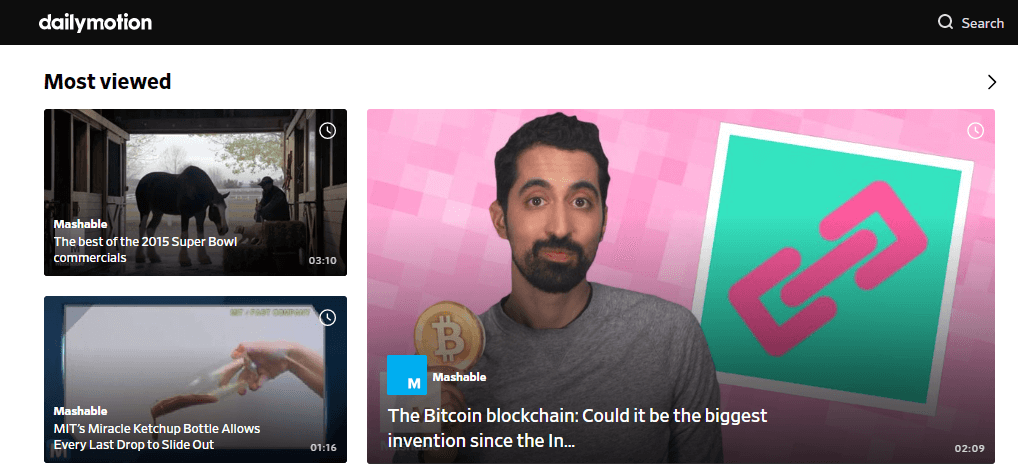By now, a lot has been said about how videos are essential for a Digital Marketing strategy.
Still, it’s important to highlight some of the reasons that we think make this type of content so relevant. We also have to address video platforms and how to host and share a video on the web.
Choosing your platform is as fundamental as producing the video in the first place: it’s where you store your content and include the tools that help you show it to everyone.
There are different options out there, offering various resources. We’re going to go through a rundown of the best alternatives you can find in order to help you.
If you want to start leveraging your videos, make sure to follow this topic all the way through. We’re going to cover:
What is a Video Platform?
Video platforms are dedicated online networks where users can upload, host, and serve up various types of video content for a wide variety of pursuits.
Brands and companies most frequently use such platforms for marketing, advertising, and content sharing purposes.
Sometimes alternatively called video hosting platforms or video clouds, video platforms allow users to host pre-recorded video content and make it accessible to an audience on an on-demand basis.
However, they can be used to live stream various events, as well. Many companies also use them for training, onboarding, and educational purposes.
Popular examples of video platforms used for multiple purposes (consumer and professional) include YouTube, Vimeo, DailyMotion, and Vevo.
Why are Videos so Important?
Now let’s summarize the importance of videos to any Digital Marketing strategy.
They are attractive, dynamic, and different. Also, they are easy to consume and understand. Customers tend to love it because they can always watch them while doing something else.
If you have a difficult concept, it’s better to break it down with a video. You can use illustration, as well as other visual languages to make it more exciting and appealing.
It’s as if you don’t have any limitations: you can draw anything and help the reader imagine whatever you want them to.
Videos are a big thing on the internet now, and you already know that. Once you realize that you want to focus more on this type of content, the next step is to think about where to host what you produce.
There are free services and some paid ones with many advantages and drawbacks. It all depends on what you want and how videos fit your company’s agenda.
After all, on the one hand, if your videos show publicly, you will need some specific options for that purpose. On the other hand, if your focus is on embedding it for your readers, you will have to look for other providers.
What to Look for in a Video Platform
Although each of the more popular video platforms out there today brings its own unique perks to the table, there are a few features nearly every business or brand would do well to look for in a potential option.
Here are some great examples.
- Customizable video player that will let you add handy features like bookmarks, autoplay, closed captioning, etc. to your content.
- Live streaming, so your brand has the option of tapping into this red hot trend.
- Solid content management ability, meaning you have the capacity to store a lot of content, as well as that it’s organized to make it easy to find what you’re looking for.
- Reliable security features and an ironclad privacy policy.
- In-video interactivity support that allows content creators to enhance their videos with useful navigation features, clickable links, and more.
- A loyal, engaged user base to discover, share, and interact with your content within the platform.
In other words, you want to prioritize video platforms that not only let you create and share video content the way you want to right now but that will give your brand room to grow in the future.
What are the Best Video Platforms?
Let’s go through some options then.
1. YouTube
YouTube is the most popular video platform and is also the second-largest search engine on the internet. That means a lot of people will see what you publish there.
The pros are: it’s easy to use, customer-centered, free, and you can easily embed the video into your blog post.
However, there are some pitfalls. One of them is that YouTube isn’t interested in seeing people leaving the website — that’s why they recommend other videos when you finish watching one.
Imagine if that happens when you embed a video on your post. That may be a huge distraction to users.
Another point to consider is that they always show ads related to something people are looking for. So, users may see an offer from your competitor while consuming your content.
Also, the analytics are not so advanced as to help a company that needs data for decision-making.
Another negative aspect is the lack of security: anyone can access your videos and steal them.
2. Vidyard
Vidyard focuses on the needs of companies. So, it’s perfect for those who require hosting to strengthen their marketing strategy and not just be virtual warehouses.
It’s easy to use and provides robust insights and integration with marketing software such as CRMs and others.
With Vidyard, you get a complete package that’s powerful enough to boost your Video Marketing. You can not only embed videos but also monitor performance, viewer location, and return over investment.
You get real-time analytics, A/B testing, and excellent support.
Some cons are:
- there are only a few editing tools;
- it can be challenging to share everywhere;
- the free version is limited;
- you have to contact them to know more about pricing.
For those who want more resources, there’s a paid version available.
3. Vimeo
Not everyone knows this, but Vimeo is actually older than YouTube. It’s also a hosting platform that shows videos publicly.
It allows brands to create live videos and to share them everywhere they want. There’s a free version, but if you need more, you can always go for the paid one.
The good thing about Vimeo is that you don’t face those problems with ads because there are none. Also, there’s a dashboard with lots of data and reports to analyze.
It’s not perfect, though. There are not enough editing resources and analytics tools.
The customer support is not excellent, and there’s a limit on weekly uploads in terms of minutes, which could be bad news for some teams.
A Love Letter to Winter from The North Face on Vimeo.
4. Brightcove
Brightcove is a simple alternative that enables live streaming, video tagging, and sharing. You get integration with all your marketing automation software and CRMs.
You can add a player to your website or social media profile. Although it’s important to point out that it lacks robust analytics tools.
5. Wistia
Wistia is also free and paid. It’s one of the options specific for businesses, which means it won’t show your videos to everyone like YouTube.
Using it, you will have an unlimited number of users and bandwidth, as well as some useful analytics tools.
Speaking of which, those analytics include engagement rates, heatmaps, and play rates. It also provides an A/B testing functionality.
The cons: the free version is very limited, and there’s a limit of monthly uploads.
If you use the free option, you get Wistia branding all over your videos, which is not a good idea strategically speaking.
When it comes to the paid version, it’s the most expensive on the market.

6. Vevo
Sporting a catchy name that’s actually short for “video evolution”, Vevo is currently marketed as the largest music video producer in the world.
It offers a completely free streaming experience, as well as one that’s highly accessible, as there’s no need for users to create an account before consuming content.
Vevo is also in partnership with YouTube, so Vevo videos stream free there, as well. This makes it an incredible option for brands or companies in the music industry looking for a solution tailor-made for them.
7. IBM Watson
IBM presents a business-centered hosting platform to create and monitor videos.
It’s good for lead generation, distribution, SEO, advertising, live streaming, video editing, and other aspects.
The solution is also powerful when it comes to security, password protection, and embedded restriction. The main issue is the user interface. It can be challenging for some people.
8. Utreon
Founded in 2009, Utreon is another of the video platforms most like YouTube, for those who prefer a familiar interface.
It supports a full range of different video types — everything from vlogs, to series complete with episodes, to instructional content.
Utreon supports subscriptions for those who are on the platform specifically to follow certain influencers.
It’s also well-known for not making creators reliant on a hidden algorithm, as well as for having rules and user terms that are far less strict than those on YouTube.
9. Cincopa
Cincopa’s video hosting features are offered as part of a comprehensive digital asset management solution.
In simple English, this means that you can use Cincopa to feature images, podcasts, and, of course, videos on your site (Wistia has recently enabled podcast hosting for customers, as well).
Businesses looking to keep video viewers on their own sites can leverage features such as Cincopa Video Channels. A Netflix-like video environment, Cincopa Video Channels enable viewers to binge on your videos free of unwanted content or competitors’ ads.
The platform’s analytical dashboard is quite robust; through an intuitive interface, you can learn how individual viewers engage with any given video.
Users can explore Cincopa during a 30-day trial period, after which they can choose from four subscription packages.

10. Kaltura
If you’re in the market for video platforms that offer users a superior ability to create highly tailored video content for professional purposes, then Kaltura is worth a second look.
Originally founded as a broadcast solution for OTT services, it’s an especially good fit for brands and companies in the media industry.
Kaltura users get access to a variety of features, including both on-demand and live streaming options. Video content is also easy to customize, as well as to brand and monetize.
11. Dailymotion
Self-described as “the home for videos that matter,” Dailymotion has been around since 2005.
Since that time, it’s accumulated over 300 million unique monthly users — an excellent user pool for any brand to tap into.
It’s also very similar in layout to YouTube, making it a viable alternative for many content creators.
Dailymotion also features a suite of YouTube-like features, as well as robust privacy protection. However, users are limited to only two hours of daily uploaded video that cannot consist of more than 96 separate pieces of content.

12. Dacast
If your company is interested in video platforms that are ideal for live streaming purposes, definitely consider whether Dacast might be a good fit for your needs.
It’s an especially good fit for companies in the media, entertainment, corporate, sports, or religious industries.
Dacast users gain access to both live streaming and on-demand video options. It also supports monetization, geo-restriction, closed captioning, password protection, and OTT support.
You can even use it to create a branded video player to make your content seem even more professional.
13. DTube
Short for “decentralized YouTube”, DTube is one of several community-powered video platforms currently gaining popularity among niche audiences.
Founded in 2016, DTube’s algorithm is powered by a voting system similar to those found on platforms like Reddit or Quora.
Users can vote for content they enjoy or consider worthy. Then creators receive cryptocurrency as a reward for high performance and outstanding content.
DTube also offers users and content consumers an ad-free experience, which gives it an edge over mainstream video platforms like YouTube.
However, it does not allow content creators to delete content once it’s uploaded.

Wrap Up
As you can see, several hosting platforms are used when a company wants to leverage Video Marketing.
You can use some free versions or paid ones for advanced analytics and more sophisticated features. It all depends on what you need.
That’s why it’s crucial to review your planning beforehand. Before choosing one of those solutions, you have to reconsider the goals of your strategy.
By doing that, you can increase the chances of success while using videos such as webinars for lead generation and engagement boosting.
Did you like our tips? If you want to know more about lead generation with webinars, check this great post about it!







